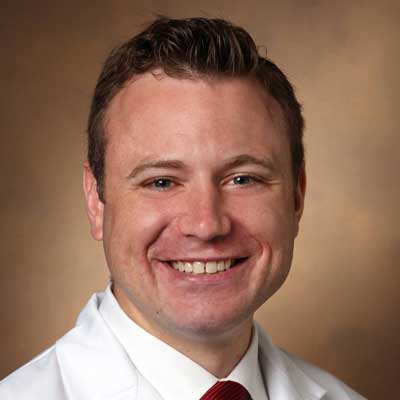Early interventions for neonates born with cyanotic tetralogy of Fallot vary across children’s hospitals. Many specialists lean toward full repair as soon the baby is stable, while others favor a staged approach, with palliative intervention followed by surgery at between 4 and 6 months to resolve the congenital heart defect.
George Nicholson, M.D., a pediatric cardiologist at Monroe Carell Jr. Children’s Hospital at Vanderbilt, is immersed in a study series on these babies along with colleagues at eight other centers constituting the Congenital Cardiac Research Collaborative.
“There is a significant population where the criteria for medical decision-making are murky. We want to add valuable data to help in making these decisions,” Nicholson said.
“There is a significant population where the criteria for medical decision-making are murky. We want to add valuable data to help in making these decisions.”
Adverse effects for newborns with cyanotic congenital heart disease are many, including developmental delay. Since neurodevelopment correlates with a baby’s growth, Nicholson and his colleagues are comparing feeding and growth patterns of babies who have received one of the two initial treatment strategies.
The team’s latest publication focuses on how management strategies involving primary versus staged repair impact the babies’ growth at age 4 to 8 months, and beyond. They looked at the effects of feeding strategies, feeding-associated medications, and feeding-related hospital readmissions to tease apart differences in the health of the two groups.
Primary and Staged Repair
Primary surgical repair for tetralogy of Fallot entails closing the large ventricular septal defect and alleviating the obstruction to enable open pulmonary blood flow, therefore creating a two-ventricle septated heart.
“This establishes virtually normal cardiopulmonary physiology,” Nicholson said.
Staged, palliative interventions include aortopulmonary shunts, right ventricular outflow tract or patent ductus arteriosus stent placement, or balloon pulmonary valvuloplasty, followed by complete surgical repair at a later date.
The Trade-Offs
The collaborative studied 383 babies – 143 of whom received primary treatment and 240 with staged-repair procedures. The work has uncovered no difference in growth over the first six months of life, regardless of initial treatment strategy. The babies demonstrated substandard growth in general across the study time period.
“When we looked at neonatal exposures in terms of complications, ICU length of stay, anesthetic duration, duration of ICU exposures, and surgical support times, they were all lower in the staged-repair group,” Nicholson said. “However, when you take the cumulative burden of the staged-repair approach over the first year of life into account, we found equivalency or a benefit to primary repair.”
The study data do show a higher early mortality risk in the primary repair group. However, the gap closes after four months of age.
“After four months, the overall risk of death is equivalent,” Nicholson said.
Feeding Methods Probed
The collaborative’s study looked at other markers of feeding and growth, such as method or mode of feeding as well as the need for feeding-related medical therapy or hospital readmission.
“Neither treatment strategy demonstrated superiority in regard to these other measures,” Nicholson said.
What did stand out was that babies who had adequate growth were more likely to be feeding orally by the time they were discharged from the index procedure, regardless of whether it was following primary repair or initial palliation in a staged repair pathway.
“If the baby is feeding by mouth, it’s probably because they are more capable, more hemodynamically stable and have less neurodevelopmental insult,” Nicholson said. “It’s a surrogate marker showing that the baby is doing pretty well overall.”
He says this data is important to collect because there is often a push to do primary repair versus staged repair to quickly normalize the cardiopulmonary circulation.
“An argument has been, if you normalize their cardiopulmonary circulation and hemodynamics, other aspects of health, like feeding and growth, should be better,” Nicholson said. “Evidence from this study does not support that as a strong criterion.”
The Series Broadens
The collaborative has also compared palliation strategies prior to complete repair and the costs of management strategies in tetralogy of Fallot, among other areas of focus.
“Now we are examining neurodevelopmental outcomes, quality of life outcomes, social determinants of health and radiation exposure between the treatment strategies,” Nicholson said. “We may also examine pulmonary vein stenosis. This is a fairly aggressive disease process in congenital heart disease, and, at the current time, there are not many good options for therapy.”






